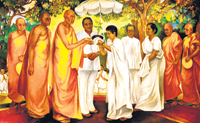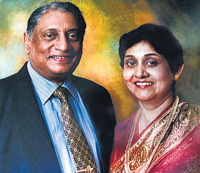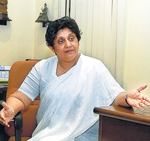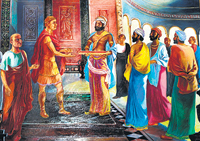|
|
|||||||
|
Memories of Lakshman A year has passed since a sniper’s bullets took his life. Suganthie, his wife talks to Renuka Sadanandan about the Foreign Minister away from politics... The large painting in its ornate gold frame commands attention. It is of a group of white clad people presenting a Bo-sapling to Buddhist monks. Some figures are instantly recognizable- former President Chandrika Kumaratunga, Lakshman Kadirgamar and Suganthie Kadirgamar.
This painting hanging in the conference room of their home brings back happy memories for Suganthie Kadirgamar of how when newly wed, the Foreign Minister had asked her if she being a Buddhist, had visited Buddha Gaya. On being told that she had not, he had arranged for them to make the trip together. The monk at Buddha Gaya had gifted them a Bo-sapling from the venerated tree under which the Buddha attained Enlightenment which they had brought back to Sri Lanka. "He told us to look after it well because it was for the good relations between India and Sri Lanka. We brought it back carefully and then President Kumaratunga suggested we plant it at Anuradhapura." The painting by Mr. Kadirgamar's favourite artist and longtime friend Stanley Kirinde done some years later, captures the moment on April 20, 1997 when it was handed over to the Anuradhapura Atamasthanadhipathi Ven. Pallegama Gnanaratana Thera at the Sri Maha Bodhi, where the world's oldest historical tree- an earlier sapling of the original tree is. One year has passed since Foreign Minister Lakshman Kadirgamar's assassination (August 12, 2005) that plunged the country into sorrow and another spiral of violence. For his wife the memories are everywhere.
The very conference room where we talk just after her return from Ganemulla from an almsgiving at the Lakshman Kadirgamar Physiotherapy Unit and Gymnasium built for the Commando Regiment, echoes his beliefs and convictions. Though born a Christian, he was a follower of Lord Buddha. "He always said that religions must unite people, not divide them. 'One must not say one religion is better than another' he would tell me. He would say, 'all religions take one to the same peak. To the peak there are many paths, one path may be longer, the other shorter, but the ultimate goal is the same peak'," Mrs. Kadirgamar says. The room has many pictures and statues, all carefully chosen by him, evidence of the respect he had for all the religions of this land; Russian Christian icons on one wall with a painting of the Black Madonna from Poland, a statue of the Hindu god Ganesh, a painting of the Kaaba by a Pakistani artist and an exact replica of the statue of the Fasting Buddha on the others. "He had read all the holy books," Mrs Kadirgamar adds, "the Bible, the Dhammapada, the Koran, the Bhagavad Gita." As she talks the portrait gradually takes shape, not of his well-known legal and intellectual acumen or his charisma as a Foreign Minister but of the meticulous work done sometimes till three in the morning, of his innate kindness and courtesy, his love for music- Bach, Beethoven and opera, and his passion for sport and avid interest in the cricket scores wherever in the world he was.
For her, the past year has been one of slow adjustment to the sorrow and loss. Continuing her own work as a partner at the law firm F.J. and G. de Sarams', the oldest law firm in the country, she has nevertheless spent much time on the many projects that her husband was involved in, many of them little known to the public. She talks of the unwavering conviction to give something back to the country that made him take to politics and his career as an eminent lawyer. They had first met in 1978, she recalls, when he was in Geneva at the World Intellectual Property Organisation and she was secretary of the Intellectual Property Law Revision Committee in Sri Lanka. The new draft law for intellectual property came from the WIPO and he used to visit Sri Lanka in connection with this. "At the time, I only knew him on a professional level and respected him as a great lawyer," she says. It was many years later that he returned to Sri Lanka and went back into practice, before accepting an invitation from Mrs. Sirimavo Bandaranaike initially to enter politics. Already much travelled, it was to be a journey that took him many miles, as Foreign Minister, serving the country for two terms from 1994 to 2001 and then from 2004 to 2005 until a sniper's bullets ended his life. The events of that tragic night are seared in her memory. She recalls how she was in the library of their private residence at Bullers' Lane in residential Colombo, supervising two personal aides working in their home, doing the monthly cleaning and dusting of the books. "Usually I would sit and watch him swim and on this day I didn't because I was busy with the books. My chair was usually on that very spot where he was killed." "He loved to stay in the water and would spend about 45 minutes to an hour swimming. He would swim continuously and not stop, he found it so relaxing and energising." She recollects how she came out and Mr. Kadirgamar after his swim had got out of the pool and donned his bathrobe, pausing for a moment to look at the garden before turning to put on his slippers. "It was at that moment that I saw him fall. I thought he had fainted and shouted to the security captain to catch him. I started running towards him and it was only when the captain shouted at me 'don't come, you'll get the shots' that I realized he had been shot." As she watched her husband being carried to the car, Mrs Kadirgamar said she felt a sickening dread that his life was over, even though it was later that night that doctors at the hospital broke the news to her. "He always told me he would be assassinated. But he was not superstitious and he had no horoscope. Yet it was something he felt would happen and he told me he felt sorry for me. We were always expecting it but still when it happens, it is very difficult." She remarks sadly how he had delighted in the birds, butterflies and bees that came to the garden of their Bullers Lane residence. He loved plants, orchids in particular and always wanted the garden to be full of flowers. Every visit to Kandy would include a stop at the Botanical Gardens and the Orchid House where he would want pictures taken of the flowers and consult the experts on whether they could be grown in Colombo. That same love extended to birds and fish and she recalls how he wanted a pond put into the garden of their Bullers Lane house so that the seven-year-old carp would have more room to swim. "It was the garden, the library, the pool that drew him to that house. He loved going there to relax. He would never have thought he would be killed in his own home. That very afternoon he had brought some small paintings by Stanley Kirinde and got them hung and was very pleased that they looked good in the spot he had chosen," she says. Stanley Kirinde, the artist whose works dominate
the Kadirgamar residence was a Trinity College contemporary and
Mr. Kadirgamar at the time of his death had just completed supervising
the publication of a book on Kirinde's art. The day he was shot
he received the first copy that had just arrived from the printers
and was so excited about its quality that he telephoned several
friends urging them to buy the book at a special rate. He took on
the role of printer, publisher and distributor. The high-class book
was launched the week after his death at a solemn ceremony-- he
was to have been the chief guest..
Other restoration projects close to his heart were the Jaffna Library project where Mrs Kadirgamar recalls he worked tirelessly with Foreign Ministry officials like Nihal Rodrigo and Kshenuka Seneviratne to get books and equipment from countries like India, the US and UK. He shunned publicity in this project as he didn't want it to be seen as a propaganda exercise but wanted it rather for the people of Jaffna and in fact, got their views when it was being planned; whether they preferred the old building restored or a brand new design altogether. He was happy when it was to be the old one restored; he loved restoring buildings, she says. At his old school Trinity while president of the Old Boys Union from 1991 to 1994 he launched a library, archives and museum project known by the acronym 'LAMP', where old boys could deposit their memorabilia and any literature connected to the school. Two of his pet projects were the Bandaranaike Centre for International Studies which through his efforts he got affiliated to many prestigious international institutions and the Institute for International Relations and Strategic Studies, now named after him which he envisioned as an independent body for researchers to delve into the omni-present geo-political currents swirling around this island nation. The past week has been packed with commemorative events; the reference at Hulftsdorp by the Chief Justice and the members of the official and unofficial Bar to a legal luminary, the unveiling of his portrait at the Law Library, the memorial lecture by India's Karan Singh at the BCIS and the opening of the Lakshman Kadirgamar Institute of International Relations and Strategic Studies where Mrs. Kadirgamar has gifted another painting by Stanley Kirinde. "Since my husband loved art, I thought the best gift would be a painting by Kirinde and asked him what he could draw. He suggested the Lankan embassy to Rome in the time of Augustus Caesar. It's the same theme as the original painting in the Foreign Ministry but done in a different way. The painting is in the auditorium where his portrait is to be unveiled," Mrs Kadirgamar says. The many projects he nurtured with such dedication will go on, but for Suganthie Kadirgamar, as to much of her compatriots, his loss is hard to bear. His tragic death has made her see things differently, understand how life can be so fleeting and also brought home the grave loss not just to herself and those close to him but to the country. "He believed that countries must not be divided and always spoke of those that had split, of the suffering and that when they did come together, it was sometimes too late. He always wanted us to speak as Sri Lankans, not as Sinhalese, Tamils, Muslims or Burghers," she says. Whether Sri Lanka can rise above its divisions, as Lakshman Kadirgamar hoped, only time will tell. |
|||||||
Copyright © 2006 Wijeya Newspapers
Ltd. All rights reserved. |



